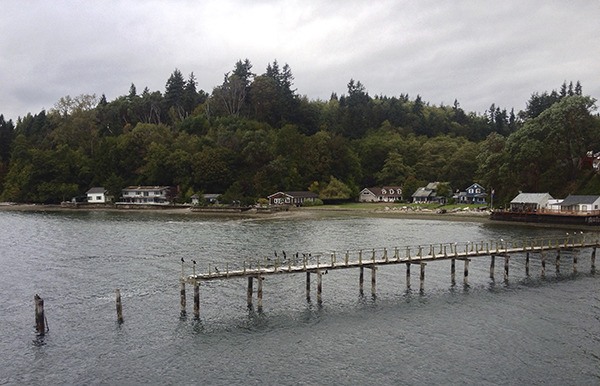In an effort to mitigate the environmental impact of the seismic retrofit of the north-end ferry dock, crews will begin work next week to remove the remnants of the old pier next to the Tahlequah dock, as well as clean up beach debris in Dockton.
Blackwater Construction has been commissioned by Washington State Ferries (WSF) to remove the creosote-soaked pilings of the old pier at the south end, in order to mitigate work on the north-end dock that will result in some increased over-water coverage, which can alter and negatively impact the near-shore environment.
Contrary to popular belief, the old south-end pier was not a historic steamer dock, but simply a fishermen’s pier, according to island historian Bruce Haulman.
Built in 1976 by the owner of the Tahlequah Store, it was essentially a last-ditch effort to stay in business — the hope was that fishermen would stop for supplies, as the store sold bait and also had a gas pump. But the endeavor was not successful. The store eventually closed, and the state purchased the site, tearing down the store but leaving the pier to deteriorate over time.
The dilapidated and environmentally damaging structure has, however, served some of the Puget Sound’s wildlife well.
Randy Smith with the Vashon Audubon Society explained that the old pier is an important spot for birds and bird watchers alike, as a roost for cormorants and other perching birds. That’s why WSF has arranged to have some untreated wood pilings put in after the old ones are removed.
“It wasn’t a situation where we felt like they had to leave the old dock in place,” Smith said, “but we did talk to them about its usefulness as a roosting site. I think it’s great that they have made this a part of the plan.”
In a recent interview about the upcoming work at Tahlequah, WSF Project Manager John Callahan also offered some new information about the organization’s commitment to reducing the environmental impact of its work at both ends of the island, when he explained that pervious concrete will be used over the new beams at the north-end dock.
Pervious concrete has a high porosity and allows water from precipitation and other sources to pass through (instead of sitting on top), reducing overall runoff and allowing for better groundwater recharging. Studies have also shown it to be effective in removing dissolved contaminants like zinc and copper from stormwater runoff from paved surfaces.
Work to remove the old pier and put in the untreated pilings is scheduled to begin next week and is anticipated to last from five to eight days.



